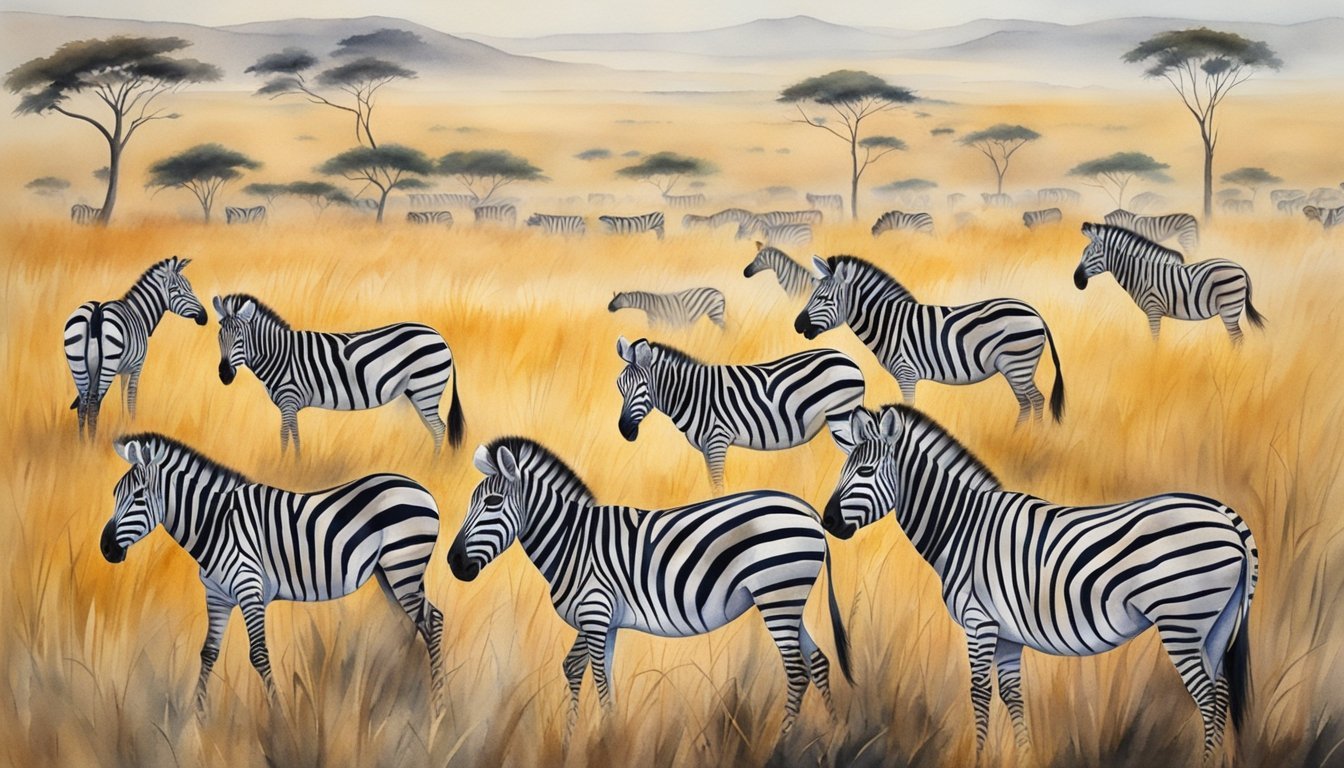Zebra Characteristics
Physical Appearance
Zebras are known for their distinctive black-and-white striped coats1. Their stripes can vary in width and pattern, with each individual having a unique set of stripes like a fingerprint. The main purpose of these stripes is believed to be for camouflage, helping them blend into their surroundings. Moreover, they have large, rounded ears to detect sounds and keep dust out2.
In addition to their unique coats, zebras also possess a mane running along their neck, made up of short, erect hair. Their tail has long, black hair that begins approximately midway down^[5^]. Male and female zebras can be distinguished by the size and shape of their body, with males generally being larger and more robust.
As for their size, zebras can range from 1.25 to 1.5 meters (4 – 5 feet) at the shoulder and weigh around 300 kilograms (660 pounds)^[1^]. They are built for speed and endurance, being capable of running at speeds of up to 40 miles per hour^[1^].
Species Diversity
There are three main living species of zebras: Grévy’s zebra, plains zebra, and mountain zebra^[3^]. Each species differs in size, stripe patterns, and distribution range.
-
Grévy’s zebra (Equus grevyi): The largest of the zebra species can be found primarily in northern Kenya and parts of Ethiopia. Their stripes are narrower compared to other species, and they have larger, rounder ears.
-
Plains zebra (Equus quagga): This is the most common and geographically widespread species of zebra, found in various habitats ranging from grasslands to savannas and wooded areas throughout eastern and southern Africa3. Plains zebras have broader stripes that are fade to gray (“shadow stripes”) near the rear3.
-
Mountain zebra (Equus zebra): The mountain zebra has two subspecies: E. zebra hartmannae (Hartmann’s mountain zebra) and E. zebra zebra (Cape Mountain zebra)4. They inhabit mountainous and hilly areas of South Africa, Namibia, and Angola. While they stand about 120-140 cm (47-55 inches) at the shoulder^[2^], and their stripe patterns may be distinctively thinner and closely spaced.
Zebra Habitats and Behavior

Social Structure
Zebras are social mammals that often form herds or family groups. Their social structures vary between species. For example, in some species, a single stallion guards a harem of females, while other species live in groups without a dominant male. Friendliness and dynamic interactions are trademarks of zebra herds.
Diet and Foraging
As herbivores, zebras predominantly graze on grass. They are equipped with strong, chisel-shaped teeth for cutting and grinding grass. Zebras have been known to travel long distances in search of water and food, making their foraging behavior a key aspect of their daily life.
Reproduction and Young
Breeding in zebras is not seasonal and can occur all year round. Mares usually give birth to a single foal after a gestation period of around 12 months. Foals are born with brown and white stripes that gradually darken to black as they grow older. The mother provides milk and protection to her foal during its first year of life.
Predators and Threats
Zebras are preyed upon by numerous predators such as lions, hyenas, and crocodiles. Their distinctive stripes act as a form of camouflage, allowing them to blend into their grassy habitat. However, conflict with humans and habitat loss has made some zebra species more vulnerable.
Conservation Status
There are three main species of zebras, namely the plains zebra (Equus quagga), mountain zebra (Equus zebra), and Grévy’s zebra (Equus grevyi). The plains zebra is classified as “Least Concern” by the IUCN Red List, while the mountain zebra is listed as “Vulnerable.” Grévy’s zebra, the most endangered, is classified as “Endangered.” Efforts to conserve zebra populations involve protecting their habitats in regions such as Africa and South Africa, as well as implementing measures to mitigate human-wildlife conflicts.

